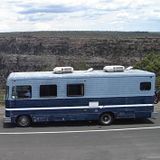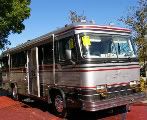Go to...  | Start A New Topic  | Search  | Notify  | Tools  | Reply To This Topic  |  |
 4/08 4/08"5+ Years of Active Membership" |
I have a failing double pane side window (water vapor). I plan to replace it with a new longer unit. I have the room, but with my investigation, I know that there will be a need to cut the existing "Z" brace at one end of the window and add a new brace farther down the wall. I have plenty of room to do this and would like some opinions on how to construct the brace. The brace is the piece between the inner and outer wall that provides support as the inner window frame compresses the wall to draw the outer window flange tight to the side wall. My thinking is this. since there is no moisture problem here I would use wood. The reason I consider wood ws for accurcy and bonding strength. I can cut a 2" wide piece to the exact width of the between the walls opening and secure it with a good adhesive to the outside wall. There are no rivets in this area and I do not want to add any outside rivets. The wood would also support the inner wall sufficiently so as to allow good compression to seal the outer flange. The window is secured in the opening by an inside ring that has screws that draw the inner and outer pieces tightly together. With the appropriate sealant behind the outer flange and an accurate cut of the side wall, the new window should be as secure and water tight as the older one (only clearer because no water vapor is trapped between the glass panels). I am looking forward to hearing your comments. By the way, I really want to add in this longer window, it will improve the view. I will be going out 6" more in length. Bill G Bill & Georgene Goodwin 92 (Feb.) Regency 36ft 300hp Cummins Gillig Chassis (1990 build date) 2014 Honda CRV toad 10Kw Power Tech Gen w/ Kubota diesel engine Can accomodate Barth visitor with advance notice  | ||
|
Bill, I fabricated a hole for an A/C in the roof of my '61 Avion in the fashion you describe, it turned out stronger than my wildest dreams. I reinforced the corners with sheet metal brackets. http://tinyurl.com/cl3zcf Steve | ||||
|
 4/10 4/10 |
Bill, with out actually seeing what the frame construction is in this area it's difficult to advise, but I wouldn't attach/adhere the support to the outside skin. The aluminum skin expands and contracts alot with different temps during any 24 hour period. Is there a way to attach it to the inside wall, maybe hide some small wood screws behind the outer lip of the ring? Ideally I would try to fabricate a frame support in the wall maybe attaching to the existing frame with aluminum corner braces. Without seeing what you are left with after removing the Z brace you're referring to it's hard to say. If you do decide on wood I myself would use cedar. 1990 32' Regency Spartan Chassis Cummins CTA8.3 Allison 4 speed | |||
|
 |
Can you go further? To the next aluminum stud? It sure would ease matters. By 'length', do you mean 'width' of the window? Taking off the interior wall panels is a pain, but it sure eases the task of cutting the larger opening needed. And also, doing so will give you access to all the vertical and horizontal framing. And from there, you could easily affix new wooden or metal framing to define an opening just larger than the window you intend to install. Matt 1987 Barth 27' P32 Chassis Former State Police Command Post Chevrolet 454 Weiand Manifold, Crane Cam, Gibson Exhaust | |||
|
| First Month Member |
Once you see how Barth did it, you can duplicate the method with full confidence that it will be done right. . 84 30T PeeThirty-Something, 502 powered | |||
|
 4/08 4/08"5+ Years of Active Membership" |
BarthBluesmobile - Yes, by length I mean width. I cannot make it to the next frame member. It will place me too close to the shower wall. I will consider inside panel removal. I agree it will make for a better installation. Steve WI - Good suggestion on securing to the inner wall rather than the outer wall. The brace, be it wood or some other material is only going to provide a ridgid spacer between the the inner and outer walls so it will not need to be super secured in place. Since the inner panel is wood, a good type III PVA wood glue will do the trick with a couple of small screws to hold it till the glue drys. Good suggestion. Thanks Bill G | |||
|
 |
If you wall is like mine, the panels are rivited in place. The annoyance is then you'd need to drill off each rivit head, and this isn't easy sometimes near the ceiling or the floor. Take the drill bit you use, and cover the shaft with tape, and that will prevent the drill from snagging on the padded ceiling. Don't go any deeper than you have to with the removal of the rivit. The body of the rivit can serve as an aligment dowel when you go to reinstall the body panel. For that reason also, you don't want to go deep in to the wall panel and stretch out the hole. By knowing precisely where the wall panel aligns, you can be aided in layout of the line to cut along for placing the window inner trim ring. Don't count on the radius of the window curves to the same. If you are keeping one corner of your new window in the same position as a corner of the old window, you may need to shift things slightly to fit the new window. So, don't count on that being a reference point for layout of the cuts you need to make. As I think about it, if I were to do my window job again, I'd get some big pieces of luan or cardboard, and "install" the window and inner trim ring to the "mock" wall. Then when I knew I had the sizes correct, I'd position and "duct tape" the outside board on the outside of the Barth, and then trace the window shape to the skin of the Barth. I'd tape strings to the template board, and have them cross at the midpoint of the window opening. Then I'd put the inner wall panel back up over the alignment dowels (old rivit bodies). Then I'd place the inside window template panel up (with alignment target in place) and align that to the outer target. And, then you'd know you'd had your inner wall cuts in the precise locations you need, and make the tracing. The tough part with this, is if your Barth is assembled as mine was, is that the wall panels went up first, and then the inner walls. So, you might not be able to completely remove an inner wall panel if it goes behind the shower area. But if you are able to precicely locate the line you want to cut in the panel, and pull it away far enough from the aluminum framing, you can then cut the trim ring cutout without having your blade interfere with the aluminum framing, or more importantly, with the outer skin of the Barth. I hope I make some sense here. But I think that the key to having a job done that you will be most proud of, starts with having the guidelines for cutting the inner wall and the outer wall properly placed. Matt 1987 Barth 27' P32 Chassis Former State Police Command Post Chevrolet 454 Weiand Manifold, Crane Cam, Gibson Exhaust | |||
|
 6/17 6/17 |
Hey Bill, If you need a hand with the window, just let me know. R.P.Muise 1994 Breakaway/Cummins 5.9/Allison transmission/Spartan Chassis | |||
|
 1/11 1/11 |
DO YOU HAVE BLUE PRINTS FOR YOUR COACH?THE FRAMING IS ON ONE OF THE PRINTS I COULD HAVE A COPY OF THE PRINT AND SEND IT TO YOU IF YOU DON'T LENNY THE PRINT IS ABOUT 24 X36 lenny and judy 32', Regency, Cummins 8.3L, Spartan Chassis, 1992 Tag# 9112 0158 32RS 1B | |||
|
| Powered by Social Strata |
| Please Wait. Your request is being processed... |
|
This website is dedicated to the Barth Custom Coach, their owners and those who admire this American made, quality crafted, motor coach.
We are committed to the history, preservation and restoration of the Barth Custom Coach.
We are committed to the history, preservation and restoration of the Barth Custom Coach.

